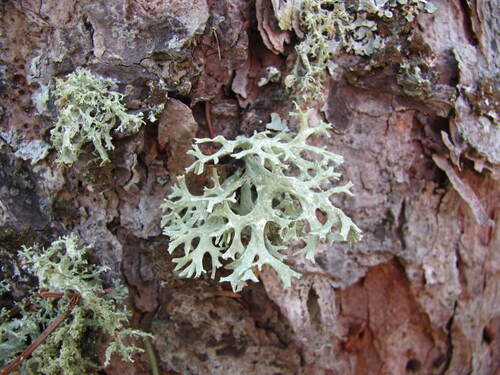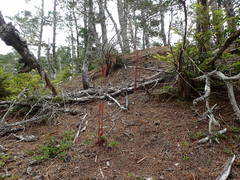Collector Name: Keith F. Saylor
Email: kfsaylor@gmail.com
Species Name: Evernia prunastri
Date Collected: May 26, 2013
State: Michigan
County: Mackinac
Township: Moran Township
Location: Gros Cap Cemetery
Habitat: Human Altered, Cemetery, Ridge along Lake Michigan
Substrate: Bark - Trunk
Host Species: Black Spruce - 80% dead
Height above ground: 3 feet and below from ground
Aspect: North
 |
| Evernia Prunastri | | |
|
| Update:August 6th, 2025 |
| Since my observations of E. prunastri in May 2013 many more observations have been posted in the northern lower and upper peninsulas of Michigan on inaturalist. |
You may view them by following this link:
Evernia prunastri observations in Michigan |
Evernia prunastri is commonly found throughout Europe and western United States. It has been documented in the United States midwest, however, it is rare in the midwest.
Lichens of North America on pages 312-313, discussing the abundance of E. prunastri in the Great Lakes region, reads:
"Some very old herbarium species exist from scattered localites in Ontario close to the Great Lakes but the species is almost certainly extinct in that area."
Records from the
Global Biodiversity Information Facility show one documented occurrence in Michigan by H.A. Imshaug on August 28, 1961 on the southern end of Beaver Island.
Dr. Alan Fryday (Michigan State University Herbarium Curator) shared in an email about the status of E. prunastri in Michigan:
In MSC we have 26 Michigan collections of E. prunastri from 11 counties
(Charlevoix, Chippewa, Crawford, Emmet, Keweenaw, Lake, Leelanau,
Mackinac, Otsego, Presque Isle & Roscommon). Although the most
recent of these collections was made in 1976.
Dr. Fryday also suggested in the same email that, while this
lichen is rare in the midwest, the records may under-represent actual abundance.
On May 19th, 2013, I observed Evernia prunastri thallus on spruce trees in the Gros Cap Cemetery west of St. Ignace, Michigan.

Update: The image above was grabbed from google maps on August 6th, 2025. It shows the trees which hosted E. Prunastri have been removed from the cemetery.
These individuals were on dead or dying spruce trees in the cemetery. One specimen was collected and sent to Michigan State University. The collections were made because the dead or dying host trees were within the boundaries of the cemetery representing a hazard to visitors and would soon be cut down.
This image is particularly compelling; it shows Evernia mesomorpha (on the lower left) next to Evernia prunastri just above and to the right. It is not common to see these forms together in most parts of the world.
Documentation:
Location: Gros Cap Cemetery
The highlighted tree on the right hosted specimens 1 -3. The highlighted tree on the left hosted specimens 4 and 5.
Originally posted June 2013. Updated August 6th, 2025.























































